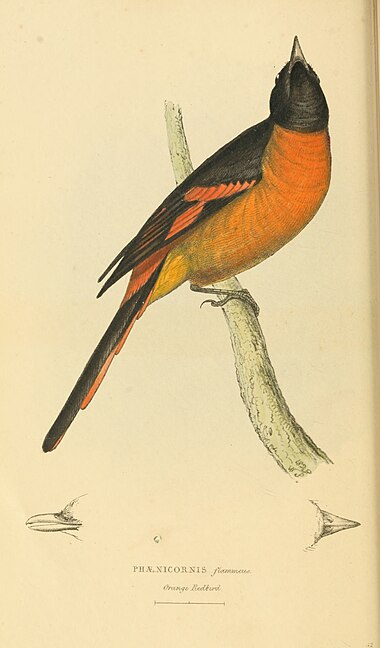Zoological Illustrations Series II/Plate 52
PHÆNICORNIS flammeus.
Orange Redbird.
PHÆNICORNIS flammeus.
Orange Redbird.
Family Laniadæ. Sub-family Ceblepyrinæ. Nob.
Generic(?) Character.
Bill with the sides compressed, the under mandible rather thick, the gonyx ascending: rictus bristled. Feathers on the back and rump slightly spinous. Wings short. Tail rather lengthened, graduated, the tip forked: the feathers narrow.
Phænicornis. Nob. Boié (pars.)
Specific Character.
Glossy black and golden orange: head, throat, wings, upper part of the back and middle of the tail glossy black; wings with two stripes of orange.
Muscicapa flammea. Auct. Tem. Pl. Col. pl. 263.
Mus. Paris. Nost.
The Birds now arranged under this group, exclusively belong to Southern India and its luxuriant Islands. About five species have been discovered, most of which are ornamented with a plumage of the brightest scarlet, crimson, or orange, relieved by glossy black. Their economy is not known, but their structure leads us to believe they live upon caterpillars and soft insects; as another group, representing these birds in Africa, are known to prefer such food. Both have the back feathers thick and rigid; although these characters are least apparent in Phænicornis. Our figure is nearly of the natural size. The female is stated to be yellow, where the male is orange. It appears to be not uncommon in Java.
The genera Parus, Turdus, Muscicapa and Sylvia have alternately been made the receptacles for these birds; to neither of which do we consider they have any immediate affinity. Their whole structure evidently accords with that of the Ceblepyrii, or Caterpillar catchers, of M. Cuvier; a group first pointed out by Le Vaillant: but as these have never been put in order, we can say nothing on the rank of Phænicornis, or on its various relations.
